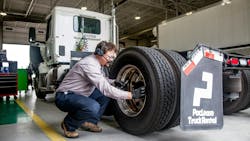Digital training tools offer flexible technician training
This is Part Two of a two-part story. Read Part One here.
In an ever-changing landscape with new technology and processes, continuous technician training isn't just a job perk, but a necessity. And it's one that technicians want, as WrenchWay found in its 2023 Voice of Technician survey, with 92% of respondents stating that paid training was one of the most important factors they looked for when applying to shops.
But making time for training when there's trucks to get back on the road is no easy feat, either. In Part One of this story, we discussed how shops can use physical training aids, from display boards to component demonstrations, to streamline training for their employees. But there are plenty of digital options as well that can allow technicians to learn on their own schedule.
Online modules
At first glance, online training through self-paced modules seems like an ideally flexible training solution. But going through modules day in and day out can lead to disengagement if not approached carefully, especially for technicians devoted to a hands-on trade.
In the ASE’s Training Managers Council 2023 Training Benchmarks Survey, 27% of technicians received training via self-paced e-learning, even though only 15% preferred this type of delivery. In contrast, 20% of respondents preferred instructor-led classroom learning, and 18% wanted instructor-led, hands-on lab training.
This doesn’t mean that there’s no place for online learning modules in technician training, as they can work well as introductory courses and reference materials.
For example, Diesel Laptops offers Diesel Repair, a digital troubleshooting guide that includes step-by-step instructions for dealing with fault codes along with service manuals, electrical schematics, and repair information.
Other digital options include the Bendix On-Line Brake School, which offers both product and system training via videos and modules on everything from the company’s diagnostic systems to trailer products and steering gears.
“[Bendix’s Brake School helps] technicians with understanding and troubleshooting the complex systems that make up today’s commercial vehicles,” said Brian Screeton, manager, technical training & service at Bendix. “These courses are self-guided and can help the technicians understand and troubleshoot the issues they encounter.”
Diesel Laptops University also provides videos, study guides, and reference materials for classes ranging from aftertreatment and emissions systems to TEXA’s diagnostics software.
Online videos
Another online option for training is demonstrative videos. Truckload carrier Ozark Motor Lines produces its training videos in-house and selects its training topics in response to issues that come up in the shop or that their technicians request.
Read more: Augmented reality: Real shop use cases
Dewey Bishop, who runs Ozark Motor Lines’ training program, produces these videos using real-life examples as opposed to pictures and diagrams, and works to keep them as direct as possible.
“I want people to see firsthand what it’s like to be on the tractor and where it’s located,” Bishop noted. “Because in the real world, they are physically out there having to touch the unit. So, I try to reproduce the exact scenario for them.”
Then, to ensure comprehension, the company pairs its training videos with knowledge checks at the end of each training session, noted Wayne Skinner, VP of fleet maintenance.
Augmented and virtual reality
Online modules and videos can also be paired with new technology, like augmented and virtual reality, to further technician training without the expense of hands-on labs or training aids, noted Rick Brady, Premier Transportation’s director of maintenance.
For example, Miller Electric’s MobileArc Augmented Reality Welding System and Lincoln Electric’s VRTEX 360 Compact both offer virtual welding training. The MobileArc system uses a helmet and welding gun mount to simulate the welding experience, while the mobile device offers real-time feedback. The VRTEX goes into greater detail with customizable variables such as gas type, process, gas flow, and amperage/voltage while simulating puddle and welding sounds.
For a more truck-centric augmented reality experience, shops can utilize platforms such as Design Interactive’s XRMentor platform. XRMentor can both facilitate interactive digital experiences or live stream real-time demonstrations to several disparate students at once, all overlaid with digital graphics, diagrams, and pictures.
About the Author

Alex Keenan
Alex Keenan is an Associate Editor for Fleet Maintenance magazine. She has written on a variety of topics for the past several years and recently joined the transportation industry, reviewing content covering technician challenges and breaking industry news. She holds a bachelor's degree in English from Colorado State University in Fort Collins, Colorado.
